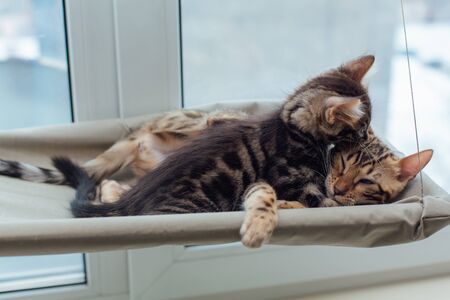The Unique Needs of Indoor Cats in the UK
When it comes to keeping indoor cats happy and healthy in the UK, understanding their unique needs is essential. Unlike their adventurous outdoor cousins, indoor cats must adapt to the British lifestyle, which is shaped by everything from rainy weather to traditional home layouts. Let’s take a closer look at what makes caring for indoor cats in the UK such a special adventure!
Climate Considerations
The UK’s famously unpredictable climate—think drizzly days and chilly winters—means that our feline friends spend more time indoors. While this keeps them safe from traffic and foxes, it also means owners must get creative with indoor enrichment to prevent boredom and keep those tails wagging (or at least swishing contentedly).
Space and British Housing Styles
Typical British homes, whether you live in a cozy terrace or a modern flat, present unique challenges for providing enough stimulation and exercise for your cat. Maximising vertical space with shelves or cat trees can transform even the smallest space into an exciting playground.
| Housing Type | Common Features | Cat Care Tips |
|---|---|---|
| Terraced House | Narrow rooms, limited garden access | Add window perches and wall-mounted shelves |
| Semi-Detached/Detached | Larger rooms, potential garden view | Create lookout spots and safe sunbathing areas indoors |
| Flat/Apartment | No private outdoor space, compact living area | Use interactive toys and puzzle feeders to keep cats active |
Safety First: Keeping the Great Outdoors at Bay
With so many urban foxes and busy roads around UK neighbourhoods, keeping cats safely indoors isn’t just a matter of preference—it’s often necessary. This means setting up secure windows (hello, classic sash windows!) and ensuring there are plenty of cosy spots for your cat to watch the world go by.
A Little Local Flavour
British homes are known for their quirks—think alcoves, bay windows, and warm radiators. All these features can be turned into delightful cat nooks or sunny snooze zones. With a bit of creativity, you’ll create a home where your indoor cat can truly thrive while enjoying all the comforts of British life.
Creating a Cosy and Stimulating Home Environment
When it comes to keeping your indoor cat happy and healthy in the UK, crafting a warm and engaging home environment is essential. British homes often have their own unique quirks—think sash windows, radiators, and cosy nooks—so making these spaces safe and inviting for your feline companion is key.
Cat-Proofing Your British Home
Start by examining your living space for potential hazards. Loose wires, exposed radiator valves, and easily toppled ornaments can all pose risks to curious kitties. Secure or tidy away anything that could be chewed, swallowed, or knocked over during a midnight zoomie session.
| Home Feature | Potential Hazard | Cat-Proofing Tip |
|---|---|---|
| Sash Windows | Escape risk, trapped tails | Install window restrictors or sturdy screens |
| Radiators | Burns from hot surfaces | Add radiator covers or beds designed for cats |
| Houseplants | Toxicity if ingested | Choose cat-safe plants like spider plant or cat grass |
Bringing British Comforts Indoors
Cats adore warmth and cosiness—a hallmark of many UK homes. Consider placing soft blankets on sunny window sills, investing in plush cat beds, or even offering an old jumper as a nest (your scent will be especially comforting). During chilly months, heated pet pads or radiator hammocks are perfect for those classic British draughts.
Enrichment for Mind and Body
A bored cat is a mischievous one! Enrich their environment with scratching posts, puzzle feeders, and interactive toys. Rotate toys regularly to keep things fresh. If you’ve got a bay window or conservatory, set up a perch so your cat can enjoy birdwatching—a favourite feline pastime no matter the weather outside.
Quick Tips for a Happy Cat Home:
- Create vertical spaces with shelves or cat trees—ideal for small UK flats!
- Set up hiding spots using boxes or covered beds
- Use pheromone diffusers to ease stress during Bonfire Night or thunderstorms
By blending classic British comforts with clever cat-proofing and enrichment ideas, you’ll ensure your indoor cat enjoys every day of their grand home adventure.

3. Nutrition and Feeding Routines
Feeding your indoor cat in the UK isn’t just about filling a bowl – it’s about crafting a balanced routine that keeps your feline friend healthy, active, and content. With so many British pet food brands available, you’re spoiled for choice, but making the right decisions can feel like navigating the Tube at rush hour! Here’s how to ensure your kitty dines like true British royalty.
Choosing Quality British Brands
The UK boasts a range of reputable cat food manufacturers offering both dry and wet options tailored for every moggie’s needs. Some well-loved brands include:
| Brand | Type | Key Features |
|---|---|---|
| Lily’s Kitchen | Wet & Dry | Natural ingredients, grain-free recipes, UK-sourced meat |
| James Wellbeloved | Dry & Wet | Hypoallergenic, gentle on tummies, great for sensitive cats |
| Harringtons | Dry & Wet | No artificial colours or flavours, budget-friendly British favourite |
| AATU Cat Food | Dry & Wet | High protein content, free-run chicken and game options |
| Scrumbles | Wet & Dry | Easily digestible, probiotic-rich for gut health, UK-made |
What Makes an Ideal Indoor Cat Diet?
- High Protein: Indoor cats benefit from diets rich in animal protein to support muscle tone, especially since they’re less active than their outdoor counterparts.
- Controlled Calories: To avoid weight gain, opt for “indoor” or “light” formulas designed with fewer calories.
- Taurine & Omega Fatty Acids: Essential for heart health and a glossy coat—look for foods fortified with these nutrients.
- No Fillers: Avoid foods high in cereals and fillers; cats are obligate carnivores and thrive on meaty meals.
- Hydration: Many indoor cats don’t drink enough water; including wet food in their diet supports kidney health.
Setting Up a Feeding Routine for the British Lifestyle
Cats are creatures of habit and thrive on routine. Here’s a sample feeding schedule tailored for busy UK households:
| Time of Day | Meal Type | Tips for Success |
|---|---|---|
| Morning (before work/school) | Main meal – wet food preferred | Feed when the house wakes up to create consistency; try warming wet food slightly for fussy eaters. |
| Lunchtime (if at home) | Treat or small snack – dry food/kibble | If you’re out, consider an automatic feeder or puzzle toy to provide stimulation while you’re away. |
| Evening (after work/school) | Main meal – mix of wet/dry food or another portion of wet food | Dinner time is perfect for bonding – use this opportunity to check your cat’s body condition and hydration levels. |
| Before Bedtime | Treat or dental chew (optional) | This can help settle your cat overnight and maintain dental hygiene. |
A Few More Tips from Our Feline Adventures Across Britain:
- If you’ve adopted a rescue or have a picky eater, try transitioning foods gradually over a week to avoid tummy upsets.
- Avoid feeding human treats such as cheese, onion-laden leftovers, or chocolate – they can be toxic to cats!
- If in doubt about portion sizes, follow the packaging guide according to your cat’s weight and activity level. When in doubt, ask your local vet or pet shop assistant (they love a good cat chat!).
- Keen on eco-friendly choices? Many UK brands offer recyclable packaging or even subscription services to reduce your carbon pawprint.
The right nutrition and routine will keep your indoor cat purring contentedly while living their best life indoors – whether perched on a sunny windowsill in London or curled up beside the Aga in rural Yorkshire!
4. Keeping Cats Active: British-Inspired Enrichment and Play
If you’ve ever watched your cat perched on a windowsill, gazing longingly at the garden birds or squirrels darting past, you’ll know how much our feline companions crave stimulation. Living in the UK, with its famously unpredictable weather, means that indoor cats need plenty of creative outlets to keep them happy and healthy. Let’s explore some quintessentially British ways to enrich your cat’s environment and encourage active play indoors.
Classic British Toys and Games
From the rolling hills of Yorkshire to the bustling streets of London, British cats have a flair for fun. Invest in toys that reflect local wildlife—think plush robins, mice, or even hedgehogs. Feather wands mimic garden birds, while felt balls can stand in for conkers from an autumn walk. Rotating toys or battery-powered “fox tails” are perfect for chasing on rainy afternoons.
DIY Enrichment Inspired by the UK
Get crafty with household items! Cardboard boxes (perhaps from your latest online shop) become castles or tunnels fit for any royal feline. Hide treats inside empty loo rolls for a game of “hunt the biscuit,” reminiscent of woodland foraging. You can also sprinkle catnip onto a tartan blanket for that touch of Highland adventure.
Climbing Solutions: Bringing the Great Outdoors In
Cats naturally love to climb and observe their kingdom from above. Consider installing sturdy wall shelves at staggered heights, creating a vertical playground reminiscent of ancient castle battlements. Cat trees wrapped in sisal rope evoke countryside trees for scratching and stretching. If you’re feeling inspired by English gardens, place safe indoor plants like cat grass near climbing areas (always check plant safety first).
| Enrichment Idea | UK Inspiration | Benefits |
|---|---|---|
| Tartan Blanket Hideaway | Scottish Highlands Cosiness | Comfort & security; soft place to nap |
| Window Bird Watching Perch | British Garden Wildlife | Mental stimulation; satisfies hunting instincts |
| DIY Cardboard Castle | Historic Castles & Ruins | Exploration; hiding; play sessions |
| Sisal Rope Scratching Post | Countryside Trees & Woodland Walks | Nail health; stress relief; territory marking |
| Puzzle Feeder with Treats | Biscuit Hunt on Afternoon Tea Table | Mental challenge; slows eating; prevents boredom |
Playtime Tips from Pet-Loving Brits
The British are renowned for their quirky sense of humour—so why not embrace it during playtime? Try naming your cat’s toys after famous British icons (“Sir Whiskers’ Mousie,” anyone?), or rotate games based on traditional holidays—like a springtime “Easter egg” treat hunt or festive Christmas bauble chase around the lounge.
Remember, regular interactive play strengthens your bond and helps keep your cat both physically fit and mentally alert, ensuring they enjoy every moment of their indoor adventures—even when it’s raining cats and dogs outside!
5. Health Care Basics: Regular Vet Checks and Preventative Measures
Ensuring your indoor cat enjoys a long, adventurous life at home starts with proper healthcare. In the UK, our feline friends benefit greatly from regular vet visits and preventative care. Let’s unravel the essentials of keeping your whiskered companion in tip-top shape.
Vet Visits: Setting the Gold Standard
Regular check-ups are key—even for house cats who don’t roam the cobbled streets or leafy lanes. British vets usually recommend an annual health MOT (that’s a full check-up, not just for cars!). During these visits, the vet will:
- Examine teeth and gums
- Check weight and overall condition
- Listen to heart and lungs
- Discuss any changes in behaviour or appetite
Scheduling these checks means early detection of common feline ailments, ensuring your pet stays purring happily.
Vaccinations: Keeping Diseases at Bay
Even if your cat never sets paw outside, vaccinations are vital. Many diseases can sneak in on shoes or through open windows. Here’s a quick reference:
| Vaccine | Disease Prevented | Recommended Frequency |
|---|---|---|
| Feline Leukaemia Virus (FeLV) | Cancer & Immune Disorders | Annually (if vet recommends) |
| Feline Herpesvirus & Calicivirus | Cat Flu | Every 1-3 years |
| Feline Panleukopenia | Distemper | Every 1-3 years |
Pest Protection: Flea and Worm Treatments
The UK’s temperate weather means fleas and worms can be a year-round nuisance. Even indoor cats are at risk—fleas can hitch a ride on clothing or visitors! Routine treatments are essential:
- Spot-on flea treatments every 4–8 weeks
- Worming tablets every 3 months
- Vet-recommended brands for best results
Accessing Pet Healthcare in the UK
Whether you’re based in bustling London or a quiet village in the Lake District, finding quality pet healthcare is straightforward:
- Register with a local veterinary surgery—many offer ‘cat only’ clinics for a stress-free experience
- Consider pet insurance to help cover unexpected costs
- Many practices offer wellness plans spreading the cost of routine care across monthly payments
For emergencies, the RSPCA and PDSA provide support for those on certain benefits, ensuring all cats have access to necessary treatment.
Top Tip from Our Furry Explorer:
“Keep your vaccination records handy—many catteries require proof before booking your cat’s next holiday!” By staying on top of these healthcare basics, you’ll ensure your indoor adventurer is always ready for their next playful escapade at home.
6. UK Pet Culture: Socialisation, Local Cat Communities, and Support
If you’re a proud cat parent in the UK, you’ll quickly discover that British culture warmly embraces feline companionship. The spirit of community and support for pet ownership here is truly unique, offering countless opportunities for you and your indoor kitty to connect, learn, and thrive.
Social Groups and Cat Meet-Ups
The UK’s love affair with cats isn’t just confined to cosy living rooms—it spills over into local clubs, Facebook groups, and even special events at cat cafés! Whether you’re keen on discussing feline nutrition or swapping adorable photos, there’s a group for every cat enthusiast. Many local councils and neighbourhoods host “cat club” meetings or organise cat-themed charity fairs—perfect places to make new friends (both human and furry).
Charities and Local Resources
Cats Protection and the RSPCA are household names in Britain, offering everything from adoption advice to vet helplines. These charities also run educational campaigns about responsible indoor cat care. For quick reference, here’s a table of popular UK resources:
| Organisation | Services Offered | Website |
|---|---|---|
| Cats Protection | Adoption, neutering, lost & found support | cats.org.uk |
| RSPCA | Rescue, welfare advice, emergency aid | rspca.org.uk |
| PDSA | Affordable vet care | pdsa.org.uk |
Local Support Networks
From community noticeboards in village halls to WhatsApp groups dedicated to neighbourhood pets, the UK excels at keeping cat owners connected. It’s not uncommon to see posters for lost cats, offers of pet-sitting help during holidays, or recommendations for trusted groomers on your local high street bulletin board.
Cultural Quirks That Make It Fun!
Brits have a soft spot for their moggies—just look at the popularity of “Caturday” posts on social media or the annual National Black Cat Day. You might spot quirky events like “Best Whiskers” competitions at summer fêtes or find pubs named after famous felines. Sharing stories about your indoor cat’s latest adventure is an instant conversation starter; you’ll never be short of tips or tales from fellow cat lovers!


